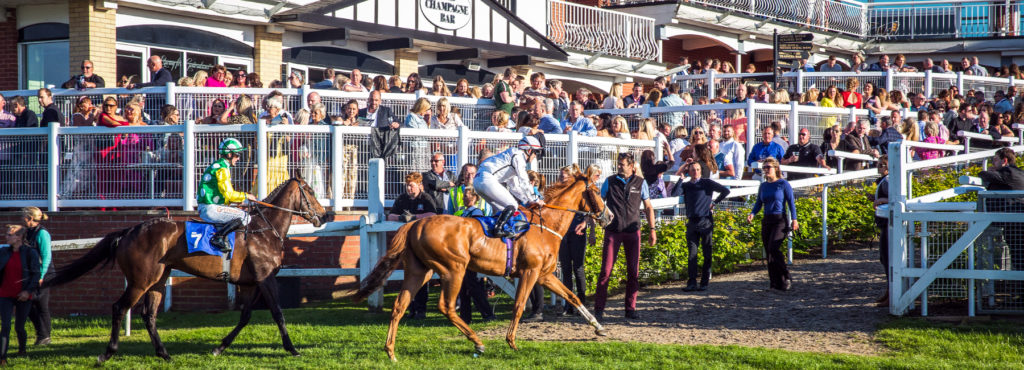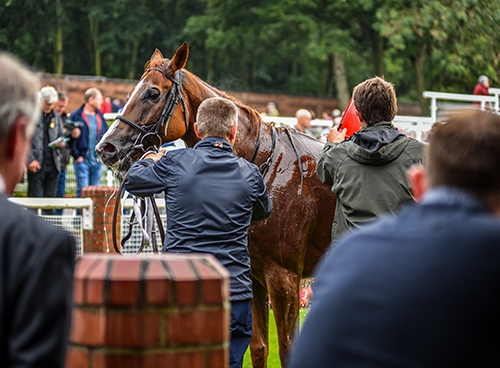OR CALL
FOR ALL NUMBERS DIAL PONTEFRACT AREA CODE (01977):
ADMIN OFFICE: 781307 | BANQUETING SUITE: 781851.


The Racecourse have a programme printed for every race meeting. This is called the ‘Racecard’ and contains details of every horse running at Pontefract on that day.
The full printed Racecard contains lots of information:
It’s a really important booklet that can help to make the day run smoothly for all racegoers.
The Racecard is designed to help you through the day and maximise your enjoyment.
Inside the front cover of every racecard is a plan of the stands and enclosures.

As well as the equine action on the track, there may well be a number of other events happening on the course on any particular day to enhance the racegoer experience.
The Racecard will have details of what is happening in particular areas of the Racecourse on each day.
For example, there could be any of the following additional events:
It’s always a good idea to have a good look through the Racecard so that you maximise your enjoyment of a day at Pontefract.
There is a lot of information packed into the Racecard!
It’s often a good place to start if you look at the heading of the race
The ages of all horses are calculated from the 1st January of the year in which they are born. Horses do not race until they become 2yr olds.
Races are run at Pontefract over distances varying between 5 furlongs and 2 miles and 5 furlongs. There are 8 furlongs in a mile.
All racehorses (regardless of their age or sex) are allocated an official rating once they have run 3 times (or once they have won a race if sooner). The British Horseracing Authority give them a ‘handicap’ rating. A horse who has not done particularly well may have a rating in the 40s, while a very good horse will be rated in the 120s or higher!
The ‘handicap’ rating can go up or down on a weekly basis.
The horse carries a saddle which the jockey ‘sits’ on to help steer. Within the saddle is an area for lead weights so that we know EXACTLY how much weight a horse carries (including the weight of the jockey).
If you look at a typical race from the racecard you will see the following general details about the race situated in the top left hand corner of the page :
The race number and time (ie the FOURTH race at 3.40pm)
The race distance (ONE MILE ABOUT FOUR FURLONGS)
The race title (THE SKY BET PONTEFRACT CASTLE STAKES)
The type of race (LISTED RACE)
The age of the horses running (FOUR YEARS OLD AND UPWARDS)
The value of the race and the prize money (£50,000 – below this, the prize money allocated to the winner, second, third, fourth etc is broken down)
A map showing where the race will start
When looking at a particular horse, looking left to right, you will see the colour of the shirt (known as the ‘silks’) that the jockey will wear. Take good note of this so that you can cheer your horse on at the finish!
After the name of the horse, you will see a number in brackets – ie 43 – this indicates the number of days since the horse last ran. If a horse has been ‘off the course’ for a long time it may indicate that it has had some training problems, been injured, or simply needed a long period of rest and relaxation.
To the right of the brackets you will see the horses age followed by the weight that the horse will carry. This weight is made up of the weight of the jockey, the saddle and the jockey’s clothing. All jockeys are then ‘weighed out’ to make sure that they are carrying the correct weight and then weighed in AFTER the race to make sure that they’ve not lost anything!
After the weight of the horse is a number in brackets. This is the horse’s position within the starting stalls.
Underneath the name of the horse you can see:
Underneath the details of the horses breeding you will see the name of the Owner, Trainer and Breeder of the horse. The sponsor of the jockey is also listed.
Underneath the weight details, you will find the name of the jockey.
Beneath the jockey and ‘colour of the silks’ details, you will see the horses ‘form’ or its finishing positions in its last 6 races.
You can expect to see any of the following symbols within the form ‘1’. ‘2’, ‘3’, ‘4’, ‘5’, ‘6’ which indicate the horse’s finishing position (1st, 2nd, 3rd, 4th, 5th, 6th).
You may also see:
‘0’ – the horse finished out of the first 6 and was ‘unplaced’
‘F’ – the horse fell
‘U’ – the horse did not fall but the jockey was knocked off or ‘unseated’
‘R’ – the horse ‘refused’ to race
‘P’ – the horse ‘Pulled up’ and did not complete the race.
A little gap after the ‘form’ may be one of the following letters ‘C’, ‘D’, ‘C D’ which are as follows:
C – the horse has won over this course (ie Pontefract)
D – the horse has won over the distance of today’s race
C D – the horse has won over the distance at this course!
Below all this information is a small review of the horse’s chances with the official rating given to it by the British Horseracing Authority (BHA) and a ‘star’ rating given by the racecard compilers.
After the very last horse in the race, you may see a line which states that certain horses are wearing ‘blinkers’ or ‘cheek pieces’ or ‘tongue strap’. The following are permitted pieces of equipment that the horse may wear on its head or in its mouth:
Blinkers – fit over the head and keep the horse looking straight forward to concentrate
Cheekpieces – fit to either side of the horse’s head and again aim to keep the horse focused by looking straight ahead
Visor – fit over the head but have a slit in the ‘cover’ to allow the horse more peripheral vision
Eyecover – fit over the head and completely blocks vision in one eye (these are rarely used)
Tonguestrap – fits in the mouth over the tongue to prevent a horse from swallowing his/her tongue.
At the end of all the runners you will see a race summary and the predicted 1-2-3!
Phew!
Each ‘type’ of race is a little bit different.
For example, a race could be restricted to a specific age group; either male or female horses; or they could all carry the same weight.
There are lots of different types of race and they are listed below:
A Handicap is a race where the horse which the Handicapper considers is the best horse in the race carries the highest weight. Typically the top horse will carry around 10st (made up of the jockey’s weight, the saddle and any additional lead weights). The ‘second best horse’ in the race may have an official rating which is (for example) 4 less than the top horse. This horse will then carry 4lbs less in weight – ie 9st 10lbs.
Between the highest rated horse and the lowest weighted horse in a handicap can be as much as 20lbs!
Handicaps are restricted to horses who have a similar ability – for example, if they are rated between 71 and 85 they can run in the same race.
A Handicap is a very competitive type of race because, if the official ratings are correct and each horse performs to the best of its ability, all horses should finish level!
It’s up to the punter to judge whether he or she thinks a particular horse is better or worse than the rating it’s got:
It’s all a matter of opinion and trying to pick out the horse that you think is better than the rating it has achieved.
A Nursery is a Handicap race (see above) that is only open to horses aged 2 years old.
A Maiden Race is for horses who have never won a race. Often there a several horses in Maiden Races who have never been on a Racecourse before. You should make a trip to the Parade Ring to have a look at the horses first!
There are different types of Maiden Races – ie a Maiden Auction, a Median Auction Maiden etc. These races are restricted to horses who were purchased at certain sales or for a certain price.
A Novice race is a race for horses that have not won more than two flat races.
Of those two wins, they cannot have won a Class 1 race or more than one Class 2 races.
The Novice races conditions can get quite complicated and the trainer of the horse can be quite astute in placing their horse in a good winnable race.
A Claiming Race is where all the horses running are for sale at a price fixed by their owners. The weight that they carry is determined by their selling price.
A Selling Race is where all the horses running are for sale. The winner will then be sold at public auction immediately after the race! At the moment, we don’t have any selling races at Pontefract.
A Conditions Race is a race where the weights are determined by a certain set of ‘conditions’.
One or more of a selection of conditions may apply in any one race. Examples of typical conditions are set out below:
A Classified Race might be described as, for example, ‘a 0-85 Classified’. This is a race where the horses are:
Listed and Group Races are for the highest rated horses.
Generally speaking horses in these types of races are allocated the same weight (although a weight allowance may apply to a younger horse or female horses). Their ‘handicap rating’ is irrelevant and they are the best horses in the country.
Group 1 races are for the very best horses – followed by Group 2, Group 3 and then Listed.